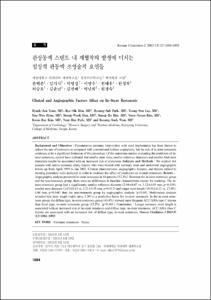KUMEL Repository
1. Journal Papers (연구논문)
1. School of Medicine (의과대학)
Dept. of Nuclear Medicine (핵의학)
관상동맥 스텐트 내 재협착의 발생에 미치는 임상적 관동맥 조영술적 요인들
- Keimyung Author(s)
- Won, Kyoung Sook; Kim, Kee Sik; Park, Hyoung Seob; Han, Seong Wook; Hur, Seung Ho; Kim, Yoon Nyun; Kim, Kwon Bae; Park, Nam Hee
- Department
- Dept. of Nuclear Medicine (핵의학)
Dept. of Internal Medicine (내과학)
Dept. of Thoracic & Cardiovascular Surgery (흉부외과학)
- Journal Title
- 순환기
- Issued Date
- 2003
- Volume
- 33
- Issue
- 12
- Keyword
- Coronary restenosis; Stents
- Abstract
- Background and Objectives:Percutaneous coronary intervention with stent implantation has been shown to
reduce the rate of restenosis as compared with conventional balloon angioplasty, but the risk of in-stent restenosis
continues to be a significant limitation of this procedure. Of the numerous studies evaluating the predictors of instent
restenosis, several have indicated that smaller stent sizes, smaller reference diameters and smaller final stent
diameters maybe be associated with an increased risk of restenosis. Subjects and Methods:We studied 164
patients with native coronary artery lesions who were treated with coronary stent and underwent angiographic
follow up from April 1999 to Jan 2002. Clinical characteristics, angiographic features, and factors related to
stenting procedure were analyzed in order to evaluate the affect of predictors on in-stent restenosis. Results:
Angiographic analysis presented in-stent restenosis in 86 patients (52.3%). Between the in-stent restenosis group
and the non-restenosis group, there were no differences in baseline characteristics except for smoking. The instent
restenosis group had a significantly smaller reference diameter (2.94±0.47 vs. 3.12±0.59 mm, p=0.039),
smaller stent diameter (3.05±0.45 vs. 3.21±0.55 mm, p=0.012) and longer stent length (19.98±4.12 vs. 17.89±
4.06 mm, p=0.048) than the non-restenosis group by angiographic analysis (p<0.05). Multivariate analysis
revealed that stent length (odds ratio, 1.20) is a predictive factor for in-stent restenosis. In the in-stent restenosis
group, the diffuse type, in-stent restenosis group (45.4%) showed more frequent ACC/AHA type C lesions
than focal type, in-stent restenosis group (15.2%) (p<0.001). Conclusion:Longer coronary stent length is
associated with an increased risk of in-stent restenosis and diffuse type, in-stent restenosis. ACC/AHA class C
lesions are associated with an increased risk of diffuse type, in-stent restenosis. (Korean Circulation J 2003;33
(12):1084-1092)
- Alternative Title
- Clinical and Angiographic Factors Affect on In-Stent Restenosis
- Publisher
- School of Medicine
- Citation
- 윤혁준 et al. (2003). 관상동맥 스텐트 내 재협착의 발생에 미치는
임상적 관동맥 조영술적 요인들. 순환기, 33(12), 1084–1092. doi: 10.4070/kcj.2003.33.12.1084
- Type
- Article
- ISSN
- 1225-164X
- 파일 목록
-
-
Download
 oak-bbb-4650.pdf
기타 데이터 / 422.9 kB / Adobe PDF
oak-bbb-4650.pdf
기타 데이터 / 422.9 kB / Adobe PDF
-
Items in Repository are protected by copyright, with all rights reserved, unless otherwise indicated.